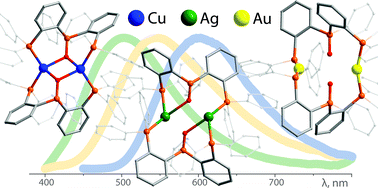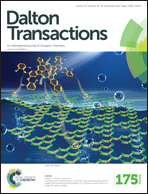Adjustable coordination of a hybrid phosphine–phosphine oxide ligand in luminescent Cu, Ag and Au complexes†
Abstract
A potentially tridentate hemilabile ligand, PPh2–C6H4–PPh(O)–C6H4–PPh2 (P3O), has been used for the construction of a family of bimetallic complexes [MM′(P3O)2]2+ (M = M′ = Cu (1), Ag (2), Au (3); M = Au, M′ = Cu (4)) and their mononuclear halide congeners M(P3O)Hal (M = Cu (5–7), Ag (8–10)). Compounds 1–10 have been characterized in the solid state by single-crystal X-ray diffraction analysis to reveal a variable coordination mode of the phosphine-oxide group of the P3O ligand depending on the preferable number of coordination vacancies on the metal center. According to the theoretical studies, the interaction of the hard donor P![[double bond, length as m-dash]](https://www.rsc.org/images/entities/char_e001.gif) O moiety with d10 ions becomes less effective in the order Cu > Ag > Au. 1–10 exhibit room temperature luminescence in the solid state, and the intensity and energy of emission are mostly determined by the nature of metal atoms. The photophysical characteristics of the monometallic species were compared with those of the related compounds M(P3)Hal (11–16) with the non-oxidized ligand P3. It was found that in the case of the copper complexes 5–7 the P3O hybrid ligand introduces effective non-radiative pathways of the excited state relaxation leading to poor emission, while for the silver luminophores the P
O moiety with d10 ions becomes less effective in the order Cu > Ag > Au. 1–10 exhibit room temperature luminescence in the solid state, and the intensity and energy of emission are mostly determined by the nature of metal atoms. The photophysical characteristics of the monometallic species were compared with those of the related compounds M(P3)Hal (11–16) with the non-oxidized ligand P3. It was found that in the case of the copper complexes 5–7 the P3O hybrid ligand introduces effective non-radiative pathways of the excited state relaxation leading to poor emission, while for the silver luminophores the P![[double bond, length as m-dash]](https://www.rsc.org/images/entities/char_e001.gif) O group leads mainly to the modulation of luminescence wavelength.
O group leads mainly to the modulation of luminescence wavelength.



 Please wait while we load your content...
Please wait while we load your content...